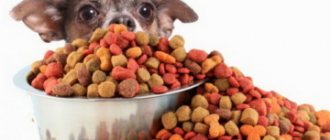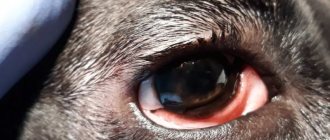Diseases and recommendations for the toy terrier - in pre-revolutionary Russia, the most popular breed was the English toy terrier. By 1950, there were no more than eleven dogs left in Russia (the Baltic republics and Kaliningrad). In 1960, the breed began to be restored by dog breeders. The import of dogs into the USSR was impossible, so an independent breed appeared - the long-haired toy terrier, the smooth-haired toy terrier with the prefix “Russian”.
In 2006, the smooth-haired and long-haired were recognized as a new breed by the FCI, and were combined into a single breed, the Russian Toy Terrier. The Toy Terrier is an emotional, excitable dog. He responds to any irritation with a loud bark. Toy is a typical “bell” dog. The dog is very susceptible to stress and will not be a good companion for children.
The most typical diseases of the toy terrier
Diseases and recommendations for the toy terrier - gastritis
- traumatic brain injuries
- compulsive behavior (masturbation)
- Partes disease
Diseases and recommendations for Toy Terrier hydrocephalus in dogs
Diseases and recommendations for the toy terrier - idiopathic epilepsy
- keratitis
- collapse of the trachea
Is the breed susceptible to diseases?
Toy terriers are considered to be quite strong dogs that rarely get sick. But this does not mean that you should not pay attention to your pet’s health. After all, illnesses can turn a cheerful dog into a lethargic and exhausted one in just a couple of days. And some of them are capable of killing a baby in just a few hours .
There are a huge number of diseases to which toy terriers are susceptible. At the same time, they are conventionally divided into several categories depending on which organ or system they affect.
The main diseases of toy terriers:
- diseases of the musculoskeletal system;
- eye diseases;
- dental problems;
- neuralgia;
- allergy;
- gastrointestinal diseases;
- skin diseases;
- other diseases (viral, infectious diseases, helminthic infestations, presence of parasites, etc.).
Expert opinion
Tolkachev Andrey Mikhailovich
veterinarian
Only a professional veterinarian can provide qualified assistance to a dog. Only he can correctly diagnose and determine the causes of certain symptoms. If your dog’s abnormalities are mild and short-lived, this is not dangerous. But if the symptoms do not stop within 24 hours, then it’s time to go to the clinic. And one more thing - never neglect vaccination and preventive examinations of the animal.
Joint diseases
Musculoskeletal problems are typical for this breed. The nimble little dog constantly moves under the feet of his owners, which is why there is always a risk that his fragile paw will be stepped on. To avoid a fracture, all family members need to be extremely careful.
An animal can dislocate or even break a paw when jumping from a great height. Hereditary pathologies include necrosis of the femoral head and luxation of the patella. Some representatives of this breed have a curled tail - a deformation similar to a step up a “staircase” leading to the tip of the tail.
Main symptoms of ailments
Sound the alarm immediately when your pet shows any of these symptoms:
- lethargy and depression;
- unnatural color of stool (black, white, greenish);
- bloody urine;
- body temperature above 39 degrees;
- the animal's refusal to eat;
- pale or reddish skin tone;
- discharge from the eyes and ears;
- dull fur;
- convulsions;
- lameness;
- sensitivity to light;
- clouding of the cornea of the eye.
Problems with the gastrointestinal tract
The most common manifestation of gastrointestinal diseases in toy terriers is:
- vomit. Causes: foreign body entering the esophagus, viral diseases, poisoning, heat stroke, helminths. Preliminary treatment: keep the dog on a starvation diet for 24 hours, give it no-shpa (this will reduce the spasm). It is also recommended to give the dog “Smecta” to remove toxins from the body and “Cerucal” to calm the gag reflex;
- diarrhea _ Causes: unsuitable food, liver disease, poor diet, poisoning, reaction to a vaccine. Help: keep the dog on a starvation diet for a while, while giving water and activated charcoal. After the diarrhea stops, give your pet yogurt or bio-kefir;
- Diarrhea with blood most often occurs when a foreign body enters the intestines, tumor processes in the intestines, parvovirus enteritis, poisoning, hemorrhoids and anal fissures. Regardless of the cause, treatment is carried out only in a veterinary clinic;
- constipation _ The reasons are the predominance of meat products in the diet, insufficient drinking, lack of fibrous foods in the diet (vegetables, fruits), and overeating. Treatment: give the dog a weak decoction of buckthorn or an infusion of pumpkin seeds (1 teaspoon per ½ cup of boiling water). You should also exclude fatty meats, flour products, dry food and bones from your diet.
Skin diseases
The most common problems in Toy Terriers are dandruff and hair loss (baldness).
Baldness
If a dog is going bald, this is a sign of the following diseases and disorders in the body:
- eczema;
- age-related changes;
- metabolic disease;
- improper diet of the dog;
- furunculosis (inflammation of the salt gland of the hair follicle).
Symptoms include symmetrical or focal hair loss in different parts of the body.
Treatment for baldness is prescribed depending on the causes that caused it. To restore hair, the doctor prescribes Trilostane and Metaonine.
Dandruff
The most common causes of dandruff in Toy Terriers:
- too dry air;
- poor nutrition;
- the presence of parasites (fleas, lice, ticks, worms);
- incorrectly selected hygiene products.
Treatment - treat the dog with antiparasitic agents and give deworming medication, and also select grooming products that do not cause dandruff. The products must be suitable for the pet. In addition, humidify the air in the room and comb out the scales with a special brush.
Your dog has a cold: treatment and prevention
A cold in dogs is not a disease in the literal sense of the word. Of course, such a state of health can hardly be called a physiological norm: it would hardly occur to anyone to say about a sneezing and snotty dog that it is in excellent shape.
In fact, cold syndrome is only a predisposing factor to the development of a more serious pathological process. However, if the symptoms are treated in time, the pet will not have any global health problems.
Main features
Characteristic symptoms of the onset of a cold are a runny nose, watery eyes, slight fever, sneezing, apathy, refusal to feed and fatigue.
It is important to keep in mind that these signs may well indicate allergies and certain viral or bacterial infections.
That is why they remember where the pet has been lately, whether it could have caught a cold outside, eaten something allergenic, or maybe lay on a draft or cold floor for a long time - this knowledge will help determine both the diagnosis and treatment.
In most cases, the cause is hypothermia of individual parts of the animal’s body or the entire body.
Most often, colds affect weakened, exhausted, overworked dogs and those animals that have suffered severe illness that depletes their vitality.
What causes a cold?
No matter how trivial it may sound, feeding disorders are one of the predisposing factors. If the diet does not have enough vitamins, minerals and other nutrients, then metabolism is disrupted, immunity and resistance are reduced, and therefore the dog’s body becomes an excellent place where microbes will happily settle.
Infections also significantly weaken the dog’s immunity and it will catch a cold faster than a healthy one.
Damp, cold rooms are the third reason. A dog (especially for small breeds) will feel most comfortable in a room where the air temperature is not lower than 20-22 C.
This must be remembered in the autumn-spring period, when heating leaves much to be desired and the pet may freeze.
To avoid this, in the off-season they use heating devices in the apartment, equip the pet with a warm lounger on an elevated surface, where he can stay warm and comfortable.
In the photo there is a corgi in a warm squirrel costume. Very cute and creative
Source: https://www.krohotun.com/veterinariya/prostuda-u-sobaki.html
Eye diseases
If your Toy Terrier’s eyes are watery or purulent, then know that this phenomenon may have several reasons:
- conjunctivitis . It is characterized by inflammation of the mucous membrane of the eye, redness of the whites, and sensitivity to light. If the cause is viruses, then drops containing an antibiotic are prescribed. If there is an allergy, then the dog should be given antihistamine drops, tablets, non-steroidal ointments;
- obstruction of the lacrimal canals . Causes: congenital anomalies, cysts or neoplasms, infections, injuries. Treatment - antibiotics, anti-inflammatory drugs and drops, as well as surgery;
- Chlamydia and mycoplasmosis can also cause purulent discharge from the eyes Treatment - eye ointments with tetracycline and erythromycin, fluoroquinolones and aminoglycosides;
- eyelid tumors (benign or malignant). Any tumor irritates the conjunctiva of the eye and puts pressure on the lacrimal canal, which leads to excessive flow of tears and the formation of pus. Treatment is surgery.
What do toy terriers get sick with?
There are also specific diseases of terriers that are more characteristic of this breed. The weak point of toys is their teeth. These dogs often suffer from the familiar caries and periodontal disease, which then lead to tooth loss.
To make this happen, watch your diet and don’t forget to brush your pet’s teeth. For this purpose, special toothbrushes and pastes are used.
Another problem for this breed is joint-related diseases. Toy terriers are predisposed to a disease called Legg-Calvé-Perthes disease. In this case, the dog begins to limp due to pain in the hip joint. This disease can only be cured through surgery. Lameness is also accompanied by medial luxation of the patella, which is also common in toy terriers. This injury also cannot be cured without surgery.
In general, dogs of this breed cannot be called sickly. Toy terriers are less likely than other breeds to develop age-related diseases related to the heart, kidneys, or gastrointestinal tract. Good care, timely vaccinations and regular check-ups with a doctor are all they need to feel good.
Small and, at first glance, fragile, handsome toy terriers, for the most part, have good health, so they rarely get sick. Diseases of Toy Terriers can affect the musculoskeletal, nervous and digestive systems. Everything is like people. Why do my toy terrier's eyes water? What to do if he breaks his paw? A toy terrier is losing its hair - what to do? We will try to give comprehensive answers to these and other questions in our article.
Causes and treatment of allergies
The most common causes of allergies in toy terriers:
- unsuitable food products;
- allergies to medications;
- reaction to insect bites;
- infections;
- reaction to the fur of other animals;
- allergies to household chemicals and care products.
Treatment methods:
- change in diet;
- introduction of homeopathic remedies;
- protecting your pet from allergy sources;
- antihistamines. The dosage should only be determined by a veterinarian in accordance with the weight of the animal;
- use of steroid ointments;
- antibiotics (if the cause is infection);
- Radiation therapy helps with severe forms of allergies.
Smell from the mouth
If your pet has bad breath, this is a reason to contact your veterinarian immediately. After all, a bad smell is a sign of illness.
If the dog does not have any diseases, then the cause of the smell is tartar or lack of care for the pet’s mouth.
What do we have to do:
- diversify your diet. Your pet's menu must include apples, carrots, and soft vein bones;
- To make it easier to remove plaque, give your pet tomato juice. At each feeding, add 1-2 tablespoons of tomato juice to your food and after 2 weeks you can easily remove plaque;
- take care of your pet's mouth. This includes regular teeth cleaning and tartar removal.
Why does a dog lose hair?
The Toy's coat, like that of other dogs, has protective functions. If you notice signs of hair loss, this is an alarming sign and you should immediately contact your veterinarian. He will find out the reasons, prescribe treatment and recommend what to do to avoid such problems. When an animal is healthy, its coat is shiny and smooth to the touch.
The causes of hair loss can be different, for example:
- result of molting;
- poor nutrition;
- allergic reaction;
- hormonal disorders;
- presence of parasites;
- improper grooming;
- stress;
- skin infectious diseases.
Shedding rate: twice a year - in autumn and spring. A toy terrier may develop allergies due to a malfunction in the immune system. The reasons that cause an allergic reaction are the following: cosmetics, toys, food, collar. Using the method of elimination, you can find out why your toy terrier developed an allergy. During the consultation, the veterinarian will help identify the allergen and prescribe antihistamine treatment.
Allergies in a toy terrier not only lead to hair loss, but the pet is bothered by itching, rashes, and the skin may peel off.
Antiparasitic drugs are good for prevention, but uncontrolled use can cause not only hair loss, but also cause flaking. As a result of past infections, the skin often peels and hair falls out. Bitches can actively shed after giving birth.
Dental care
The fact that the Toy Terrier is a small breed dog does not mean that it has fewer teeth than others. There are as many of them as other breeds. The toy has 20 teeth on the upper jaw and 22 on the lower jaw. An adult healthy dog has 42 teeth.
Between 4 and 6 months after birth, the puppy's baby teeth change. The root of the baby tooth dissolves and the crown becomes loose. By the age of 8 months, the process of changing teeth is completely completed.
Between the ages of 1 and 2 years, your dog may experience loose molars that may fall out.
Causes of loss of molars:
- hardened plaque, which over time destroys the chewing organ;
- advanced gingivitis is a disease that causes inflammation of the gums, leading to loose teeth and tooth loss;
- periodontitis is an inflammation of the gums, accompanied by bleeding, pus and pain.
Dental treatment plan for a toy terrier in a clinic:
- Carrying out diagnostics and taking tests;
- Cleaning teeth, removing tartar, removing decayed and broken teeth;
- Prescription of anti-inflammatory, antiseptic and enzyme drugs to eliminate inflammatory processes;
- If there is no improvement, then antibiotics are prescribed.
Teeth cleaning:
- buy cotton swabs or a children's toothbrush, as well as toothpaste for dogs and a hook for removing tartar;
- If possible, position the dog so that it is comfortable for both you and her. Some people advise placing the baby on your lap;
- walk over your pet's teeth with a cotton swab or toothbrush with toothpaste, moving from the gums to the edge of the tooth. Pay special attention to the painters (far teeth);
- now, if there is plaque, carefully remove it with a hook or an orange stick. If the plaque has already become hard, you will have to visit a veterinarian.
NOTE!
When brushing your teeth, your goal is not to scare your pet. Accustom him to the procedure gradually, talk to him, encourage him.
Cold and runny nose in a dog. What temperature is normal? Adviсe
A strong immune system allows a dog to live its happy canine life without health problems. However, the activity and friendliness inherent in our four-legged friends often does not allow the animal to restore the physiological resource of the body.
No, we do not encourage you to lock your pet within four walls and walk around the park exclusively on a short leash at a leisurely pace. We are talking about your attention to the first signs of a cold in dogs, which without proper treatment can lead to serious consequences.
An animal cannot catch a common runny nose from its owner, and strains of acute human respiratory viral infections do not pose a danger to a dog. But a pet's runny nose can be caused by bacteria that infect the animal's respiratory tract. In this case, the symptoms are similar to ARVI.
What affects a dog's susceptibility to disease?
The frequency and susceptibility to colds are influenced by the following factors:
- heredity. A dog with a weak gene pool literally attracts all kinds of colds like a magnet.
- dog's age. The older the pet, the weaker the body's protective functions.
- hypothermia. This does not mean that the risk of colds increases in animals swimming in an ice hole. To catch a cold, a dog that gets wet in the rain only needs to be exposed to a draft or be exposed to low air temperatures for a certain period of time. The animal’s body will not be able to provide natural thermoregulation for a long time, and is guaranteed to lead to freezing of your pet.
It should be noted here that this factor is most characteristic of animals of small ornamental breeds, such as the toy terrier. Because toys have a high base body temperature, hypothermia is more damaging to them than to large dogs.
- conditions of detention. The immune system is not only suppressed by viruses. The health of the animal weakens due to poor nutrition, uncomfortable temperature and air humidity in places where it is kept, non-compliance with the vaccination schedule or lack thereof.
- contact with sick dogs. Of course, there is nothing easier than taking your pet for a walk and standing on the sidelines while she frolics with her relatives. But, do not forget that your pet is contraindicated from communicating with other dogs if they are not vaccinated or sick. Either ask the owner of the sick dog to leave the walking area with their pet, or go with your four-legged friend to a safe place.
- parasites. All kinds of parasites undermine the animal’s immune system, and in addition to rewarding the animal with dangerous infections, they give the “green light” to additional diseases, such as colds.
Symptoms of rhinitis or runny nose are familiar to every person. Nasal congestion, coupled with constant discharge, takes dogs out of their usual rhythm of life. Only a pet cannot put drops in its nose on its own or drink hot milk with honey. For this he has you.
If the dog sneezes and grunts, rubs its muzzle with its paw, then examine the animal for other signs of a runny nose:
- nasal discharge of varying consistency (transparent, yellow, green).
- difficulty breathing.
- During sleep, the animal began to snore and sniffle.
- rubs the muzzle in the nose area with its paws.
- The pet experiences a decrease or complete loss of appetite.
- the animal sneezes.
- Tears flow from my eyes.
- Due to nasal congestion, the dog's sense of smell worsens.
Treatment of runny nose in dogs
Before you begin treating a runny nose in a dog, determine the cause of the runny nose. Did your four-legged friend walk for a long time in the cold rain or got into a fight with the neighbor's Sharik and hurt his nose? The course of treatment depends on what exactly caused the excessive nasal discharge.
So, let's examine the pet's nasal passage. This is best done with a flashlight. There are often cases when the cause of a runny nose is a foreign body that has entered the nasal passage. If the cause is indeed a foreign body, then you need to carefully remove it from the animal’s nose, or seek help from a veterinarian.
If, in addition to the symptoms of a runny nose, the dog has a gastrointestinal tract disorder, difficulty breathing and a reluctance to play and communicate, then this is not a matter of a common runny nose - take the dog to a dog doctor.
An active four-legged friend with some water under his nose can cope with a runny nose in 2-3 days thanks to his own immunity.
But, if after the third day your nose is running, and the consistency and color of the discharge has changed, then you need to start treatment, which is as follows:
- Thick discharge is removed from the nose using cotton swabs, which need to be moistened in warm water.
- dried crusts are carefully cleaned off with a cotton pad soaked in a decoction of chamomile or hydrogen peroxide (3%). After removing the crusts, the beginning of the nasal passage is lubricated with Vaseline or (as for children) oxolinic ointment.
- the dry nose is treated with streptocide, crushed into powder (ready-made streptocide powder is sold in pharmacies).
- Salt will help relieve congestion and make breathing easier for your pet. Pour heated salt into a fabric bag and hold it on the dog’s nose for a couple of minutes. This procedure is repeated several times a day.
- There are no special dog drops for the runny nose, so we will use our drops based on natural herbs and oils, for example Pinosol and Eucasept. But you shouldn’t overuse them; you only need to drip them if your nose is completely clogged.
- But you can safely drip decoctions based on medicinal herbs (chamomile) or ordinary vegetables (carrots, beets) onto your dog’s nose.
If your dog has a runny nose, you need to feed it warm liquid food. This will make it easier for the dog to eat, and it will eat its allotted amount. If you feed your pet ready-made food, then dilute it with water, again, to make it easier for your pet to eat. And one more thing - drinking water should be warm.
Additionally, help your dog’s body by supplementing the diet with vitamins A and E. These can be either special supplements or the food itself.
For a few days, while you are treating your dog’s runny nose, reduce the walking time. There should be no drafts in the house and try not to bathe your pet until he is completely recovered.
Dog body temperature
Each of us knows that a dog’s nose is a kind of indicator of the animal’s health. If your pet's nose is hot and dry, we clearly understand that the cause is an increase in temperature.
Although elevated body temperature does not always cause a dry nose.
So you shouldn’t trust only tactile sensations, but it’s better to take a thermometer and measure this important indicator of the animal’s well-being.
Normal dog temperature
In addition to diseases, the change in a dog’s body temperature is influenced by the breed, the age of the dog, the bitch’s pregnancy, the environment, and the ambient temperature.
So, on average, a dog’s temperature ranges from 37.5 to 39 degrees, but representatives of large breeds have a normal body temperature ranging from 37.3 to 38.3 degrees; medium - from 37.5 to 39 degrees; small ones, such as a toy terrier - from 38.5 to 39 degrees. And this applies to adults.
For puppies of each group, this indicator increases by 0.1-0.2 degrees, since the metabolism of babies proceeds much faster than that of their mothers and fathers. The same applies to small breeds. The metabolic process in a toy terrier occurs faster than in a Caucasian shepherd dog, which means the body is warmer.
Temperature in dogs with colds
Any change in a dog’s body temperature during a cold is a sign of the body’s fight against infection. If a dog's temperature is outside the normal range during a cold, it means the cold is viral.
It’s difficult to get by without a veterinarian. And you will need a trip to the veterinary clinic or a call to a specialist at home. This is necessary to exclude dangerous diseases, the symptoms of which are fever.
It is necessary to bring down a dog’s temperature at home only when it rapidly rises and the pet’s condition worsens. While waiting for the veterinarian to arrive, you can alleviate the condition of your four-legged friend with the help of:
- analgin tablets.
- Inject intramuscularly a mixture of analgin, diphenhydramine and no-shpa in a ratio of 2:1:1.
When you are going to transport a dog with a temperature of 40 degrees to a veterinary clinic, try not to disturb the animal again, but apply ice in a bag and a towel to its body.
Source: https://rus-toy.com/prostuda-sobak/
The appearance of seizures
Causes of seizures in a toy terrier:
- epilepsy . It can be inherited or caused by head trauma, complications from infection, tumors, etc.;
- diabetes mellitus and complications after it. Typically, convulsions in this case appear due to an acute lack of glucose;
- poisoning (severe intoxication of the body). As a rule, this happens when a dog is poisoned by poisons such as arsenic, rat poison, insect repellent, etc.;
- infectious diseases . Their causes are viruses, bacteria, fungi. Very often, convulsions occur after a tick bite. In this case, an increase in temperature, discharge from the nose and eyes, and intestinal disorders are often observed;
- inflammatory processes of internal organs . The most common cause is an infection in the dog’s body, which causes a variety of diseases (meningitis, hepatitis, nephritis, etc.). Cramps are just symptoms;
- heart diseases . In addition to seizures, heart disease in Toys is accompanied by shortness of breath, cough, and bluish skin;
- oncological formations in the brain . With this disease, the pet may have severe convulsions, unsteady gait, weight loss, and inappropriate behavior.
First aid for seizures:
- transfer the animal to a flat surface and make sure that it does not injure itself or choke on saliva;
- turn off the radio and TV, loud sounds can aggravate the dog’s condition;
- drop a drop of Valocordin on your pet’s tongue - this will help him come to his senses quickly;
- Injections of magnesium sulfate can help your pet, but this should only be done with the permission of a veterinarian;
- if the dog has come to its senses, you should not feed it immediately, it is better to give the pet some boiled water at room temperature;
- Diazepam and Phenobarbital are often prescribed for seizures in toy terriers. But they can only be given after consultation with a veterinarian.
IMPORTANT!
After the seizures have stopped, take your pet to the vet immediately!
Neurological problems
The most common neurological disease among Toychiks is hydrocephalus, the symptoms of which are manifested by convulsions and aimless circling in one place. As a result, limb paralysis may occur. If your pet's paws are shaking or you notice convulsions, contact your veterinarian immediately. In general, seizures in a dog are not a pleasant sight. They come in several types:
- jerky convulsions;
- slow and prolonged cramps;
- clonic;
- epileptic seizures.
Epilepsy is a serious neurological disease. Seizures usually do not last very long. To take a dog with seizures to the veterinarian, it is best to wrap him in a soft, warm blanket.
Such an animal must be protected from stressful situations. At a time when your four-legged friend is shaking violently, the main thing is to protect him from injury. Make your toy comfortable, away from sharp corners, hold his head and don’t try to put anything in his mouth.
Similar article: How long do toy terriers live and what does it depend on?
However, cramps can also be a consequence of a lack of vitamins. Tremor of the limbs can be observed in lactating bitches. In a word, only a specialist can determine exactly why your toy terrier is trembling. Neurological problems appear during puppyhood. Often the dog requires surgery, so it is important to monitor the baby’s behavior so as not to miss any alarming symptoms.
If you hear your dog grunting, this is most likely a development of tracheal collapse. The narrowing of the lumen of the trachea as a result of softening and sagging cartilage leads to the fact that it grunts. The toy seems to want to get rid of a foreign body, which is accompanied by grunting. A dog will also grunt if it has chracheal prolapse. In this case, the trachea loses its elasticity.
A complex attack, when the dog grunts intensely, can be relieved by pressing your fingers to the nostrils for a while. Animals with severe collapse require surgical intervention. Under normal conditions, when a dog grunts, you need to pick it up and massage the area where the trachea is located for a while.
Causes and treatment of cough
There are several associated symptoms to look out for if your dog is coughing:
- discharge from the nose and eyes, inflammation of the mucous membranes;
- weight loss;
- apathy;
- increased breathing rate;
- uneven breathing;
- increased body temperature;
- enlarged lymph nodes.
Schemes and methods of treating cough depend on the causes that caused it.
Causes and treatment of cough:
- dry cough occurs with viral and infectious diseases. In this case, the dog is prescribed antiviral drugs or antibiotics, as well as expectorants;
- If the dog is coughing due to a foreign object getting into the throat, carefully examine the mouth and try to remove it. If the cough does not go away, contact your veterinarian;
- if the cause of the cough is an allergy, then the pet should be treated only after the allergen has been definitively identified. Treatment - antihistamines, special diet and isolation from the irritant;
- helminthic infestation can cause tracheobronchitis in a dog and, as a result, a suffocating cough. This disease should be treated only with antiparasitic drugs;
- A lung tumor almost always causes a cough in a Toy Terrier. Bronchodilators, steroids and bronchodilators will help alleviate the condition. If the tumor can be removed, the pet will be able to completely get rid of the cough.
Also read about what to do if your toy terrier is wheezing and choking.
Diseases
Like other animals, they have various health problems, including genetic ones.
But despite this, his body is quite resilient and resistant to external invasions. But resilient does not mean strong. The point is that if an illness (even a seemingly minor one) gets to him, then where another dog recovers in a couple of weeks, the other dog will literally wither before his eyes. And severe chronic and infectious diseases can even lead to death in a matter of hours.
That is why, in the case of toy terriers, it is more than important to constantly monitor their slightest behavioral and physiological changes, look at how they communicate with their family and owner, and also how much time they devote to games and food. It is necessary to vaccinate regularly, in accordance with the designated vaccination schedule (especially for young dogs).
And, of course, if you notice any deviations, you should not try to treat them yourself, but should contact a specialist in this field, whose number should be at hand.
Let's look at typical cases of health difficulties in this breed.
Musculoskeletal system
One of the most dangerous canine medical diseases. Medical conditions in this category usually affect the dog's ability to move. How much movement is impaired depends on the type and severity.
Skeletal and joint pathologies are the most common, but problems in the musculoskeletal system can also indicate muscular, neurological deviations, toxins in the body, hormonal abnormalities, metabolic disorders, infections, blood and vascular diseases, as well as malnutrition, birth defects.
Many canine organs rely entirely on muscles. A dog's ability to see, breathe, urinate, reproduce, and even chew and swallow can be affected by muscle condition. So if they fail, they can refuse. Physiological disorders of the musculoskeletal system that mainly affect muscle membranes and related fibers are called myopathy. Muscular membrane disorders can be either hereditary or acquired. Diagnosis of myopathy usually requires laboratory tests.
Tendons do not stretch, so they are easily injured and can rupture if force is applied to them. Such injuries lead to tendonitis, which is inflammation of the tendons. Because tendons and ligaments have a relatively poor blood supply, they heal slowly and sometimes not completely. If a dog as small as that one injures tendons, rehabilitation will require patience.
Bone diseases usually appear at birth, as a result of nutritional deficiencies, or after injury. Genetic abnormalities in Toy Terriers include cases of hip dysplasia or the presence of extra digits (polydactyly). Unbalanced levels of minerals in the daily diet, especially minerals such as copper, zinc and magnesium, are a common cause of bone defects. Growing puppies that have too much protein in their diet may also develop abnormally.
The same applies to some vitamins, especially vitamins A and D, which have an effect on bone growth and physical development. Most bone disorders result from various injuries, such as fractures or cracks. Infections that cause bone destruction are also a common cause. In other cases, ligament or tendon problems can cause secondary bone problems.
Moving joints are vulnerable to internal ailments and disorders that affect their membranes, as well as a variety of ligaments, cartilage and bones. The diseases can be caused by injury to the joint, long-term inflammation, developmental difficulties, or infections. Traumatic injuries can lead to short-term consequences such as a dislocation, fracture or sprain. Longer-term effects may include arthritis or rupture of adjacent ligaments/membranes.
Chronic or long-term inflammation is most often seen in joints associated with movement. The consequences of long-term inflammation can be complex. Any injury to the joints changes the composition and amount of fluid inside them, which affects the overall pressure on the connecting bones. Injuries also increase the level of white blood cells inside it, which over time can destroy cartilage.
However, in recent years there has been significant progress in the methods of diagnosing and treating diseases of the musculoskeletal system, and with early detection of disorders, they can be corrected, allowing the animal to fully return to a healthy life.
Neuralgic pathologies
The most common of them is hydrocephalus (a congenital malformation that is characterized by excessive accumulation of cerebrospinal fluid (CSF) in the cerebral ventricles as a result of a violation of its outflow.
This process leads to compression of various parts of the brain and further atrophy of the nervous tissue. Subsequently, the animal changes physically: its skull shape changes, circular movements are observed, it constantly turns its head to the side, while its vision is greatly reduced and convulsions systematically occur.
Toys are prone to this disease; all of these symptoms can appear from about one and a half months of age and continue until the end of his life. They can be triggered even by slight stress. The disorder is treated with diuretics, anti-inflammatory and anti-shock drugs.
Another well-known Toy disease is atlantoaxial instability. This is essentially the appearance of severe pain and powerful shock physiological stress, leading to immobilization of the animal, due to the occurrence of pathological mobility (movement occurs in a place where there is no joint) between the I and II cervical vertebrae.
This can happen either as a result of a congenital anomaly, an underdeveloped vertebra, or due to damage to the vertebrae, or direct physical rupture of ligaments. In this case, the animal experiences constant weakness, incoordination of movements, drowsiness, pain in the limbs and neck, etc. Atlantoaxial instability can be diagnosed using X-ray examination of the cervical spine.
Other
- Toys may also have eye disorders that are genetic in nature. As a rule, these are various conjunctivitis, as well as cataracts caused by aging.
- Periodontal disease and tartar, as well as premature tooth loss. The way out of this situation is to regularly take care of your teeth and monitor your dog’s diet.
- The dog can have an allergic reaction to any irritant: from fingers and other common factors to people passing by. Allergies are a typical hereditary trait that never escapes the breeder, so before buying him you should definitely ask about his parents.
- Incorrect, non-compliance with veterinary recommendations and simply excessive nutrition can lead to a disorder of the digestive system or to one of the most important diagnoses not only of toy dogs, but of the entire canine brother in principle - obesity. This applies to the choice of food, diet, following the veterinarian’s recommendations, etc. There is nothing more important than sticking to your diet.
- Also, leaving a dog on the street unattended has huge consequences. If the dog is not vaccinated, then he has a huge risk of contracting an infectious disease, such as plague, hepatitis, etc. On the street, he can also become a victim of a tick and become infected with pyroplasmosis. And if he gets hypothermia, this can subsequently cause severe renal and bronchopulmonary ailments with dire consequences.
By the way, about vaccination. It is necessary to do it. If the dog was adopted from a kennel, then it should already be vaccinated with all the relevant documents. But some people take puppies from pet stores, or even from the street, and everything is much more complicated there.
So, according to the usual scheme, when vaccinating a puppy for the first time, you will have to carry out this procedure twice. The first stage occurs when I am 5-6 weeks old, and the second after 2+ months.
However, the first vaccine does not provide protection against infections, but only prepares the body for the next, control stage. And here it should be noted: this inter-vaccination period, when your pet’s body is not protected in any way, is an incredibly dangerous time. As the owner, you must provide him with quarantine and exclude any contact of the puppy with dirt, dust, sewage and other sources of dangerous bacteria - with the street, hallway, balcony, and so on.
Of course, you need to keep the house clean and look after your ward too. The curfew must be strictly observed until it ends after receiving the second vaccination (this happens within about half a month).
Thus, a puppy vaccinated only once is practically the same as a puppy without vaccinations at all. This information needs to be taken into account when dealing with some unscrupulous breeders.










